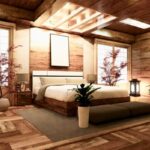Simple interior wall cladding, which can be made from shiplap or salvaged barnboard wood, is making a comeback. It gives rooms style and texture, as well as rustic charm. Here are some tips on how to use them. Audrini Living offers Largo Wall Panels that is distinctive, authentic and modern. All of our wood panels are handcrafted using responsibly sourced materials. We are passionate about wood, nature, and art. This is why we try to incorporate these values into our panelling.
Wood walls have a long and rich history. Early colonial times saw boards and shingles being used to cover the house’s skeleton. The partition walls were made of planks. Later, vertical boards were attached to studs with decorative beads or chamfered Vs along their edges.

Paneling was a common method of covering walls that weren’t plastered. The wealthy could have fancy woodwork but most homes used flat-backed claddings that were similar to the ones on the exterior. These included boards with interlocking tongue-and groove joints or “lapped” joints to keep out cold winds and water. In Victorian times, decorative beaded boards were used to cover walls in kitchens and bathrooms.
Do Your Prep Work: Important Questions To Ask
What is the Cost?
Unfinished pine boards are less expensive than unfinished, while reclaimed wood can run up to $20 per foot. Unfinished, a standard 4×8-foot MDF panel costs about $30. Individual beaded pine boards cost about $2 per linear feet.
Do you want to DIY or hire a pro?
This project is great for the experienced DIYer. It is important to start off level or plumb and work around windows and doors. How to build a ceiling. Pros may be your best option.

Where can I buy it?
Many manufactured-wood and MDF products are sold at home centers, sometimes in kits. Lumberyards will carry higher-quality wood cladding, but it might be an exclusive order.
Maintenance?
Wood cladding should last for the lifetime of your house as long as it is properly installed and has enough room to expand. MDF is more vulnerable to moisture damage and dings.
Different types of interior wood paneling
Shiplap
Here are some examples of the most common types of cladding. The profile and the finish you choose all have an impact on the overall effect.
SHIPLAP is a type or joint and not a decorative cladding treatment. To ensure a tight seal, horizontally laid boards are rabbeted along the sides.
It is not uncommon to have them milled with a nickel gap of approximately 1/8 inches along the top edge. This creates a shadow line that highlights individual boards. DIYers will often add lauan or MDF strips to the wall, with space between them to suggest shiplap.
Beadboard
BEADBOARD is traditionally stick-built. It is made from 2 1/2-inch wide strips of wood. The tongue side has a beaded edge and the groove side has a matching rounded edge. They can be joined together to make a continuous wall covering.
It is possible to replicate this look using wider planks and MDF sheets or plywood with rows of beads.
V-Groove
V-GROOVE boards have chamfered edges on each side. This creates a V-shaped joint when the tongue and groove (or shiplap), joints join. V-groove planks of varying widths were common wall cladding used in colonial-era houses. They were often painted matte. They are valued for their simplicity, much like square-edged shiplap. They are available in wood, MDF and synthetic materials, for various purposes.
Board-and-Batten
BOARD-AND BATTEN is traditionally constructed as a series vertical boards that are overlaid with 1x material or battens. The lumber used for siding is usually roughcut. Nowadays plywood can be used indoors with 1x strips placed every 8-10 inches covering any joints. You can attach battens directly to the wall and then unify the entire assembly with trim paint. This is a popular DIY trick.
Get rid of the siding
Drop Siding is an older type of shiplap that has a cove at the top to encourage water shedding. You will get channel siding if you square off the curve. It is easy to transition from exterior use to interior use because it is flat-backed, unlike beveled sidings like clapboards. You can have a bead added to the bottom of your siding or any other customized detail from millwork shops.
Rustic Planking
RUSTIC PLANNING can include anything, from barn boards to pallet wood to common lumber that has been given a new look by a finishing process. You can nail planks together with very little space between them, but be sure to stagger the joints. Boards might not have rounded edges to hide gaps and may require space for expansion. The wall can be painted black to prevent any other colors from showing through.
Installation Advice
Before you start, whether you hire a professional or DIY.
Wood requires space to move
A wood-clad wall should have at least 3/8 inch expansion space. This includes the area above the baseboard where it meets the ceiling and the corners where adjacent walls begin.
You can trust construction adhesive as your friend
You will need to use fewer nails because it can hold up to 30% of the bond. It may be all that you need with lightweight material.
Begin with a flat surface
Start by attaching a grid of strapping to uneven plaster or masonry walls. Shimming as necessary will make the surface completely flat. To attach horizontal furring strips or plywood, nail vertical boards.
The first board should be level or plumb
Do not rush to install the first board. If it isn’t level or plumb, you run the risk that every piece will be crooked. You may have to scribe the boards to fit if your walls or floors are not level.






